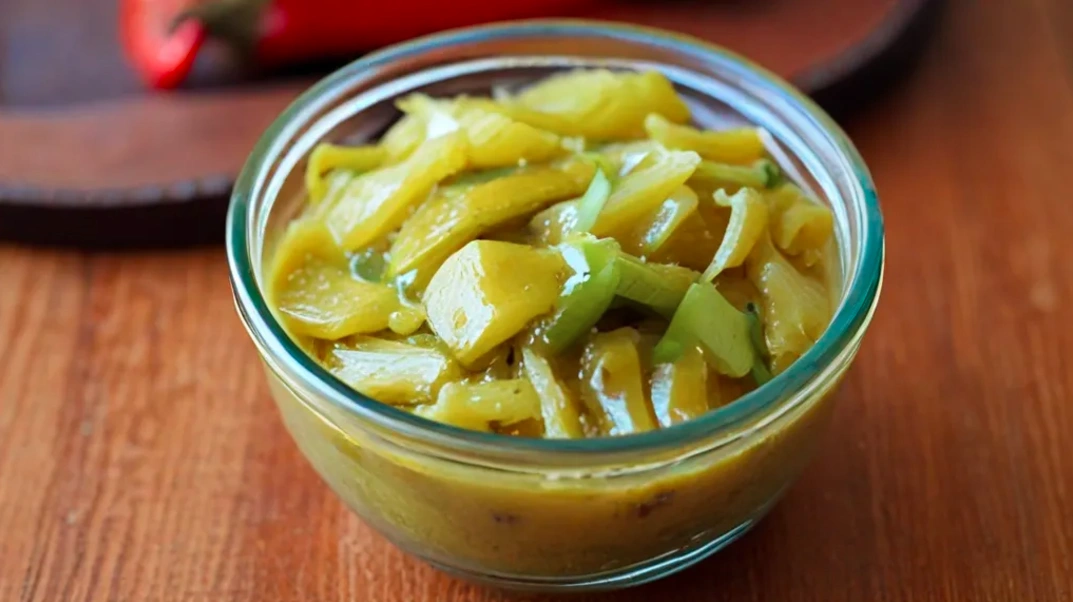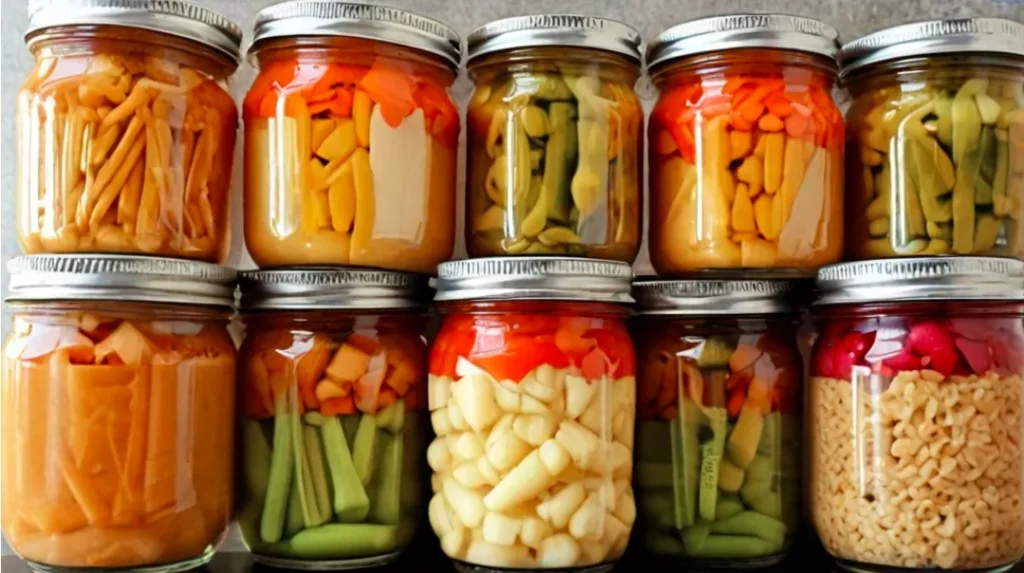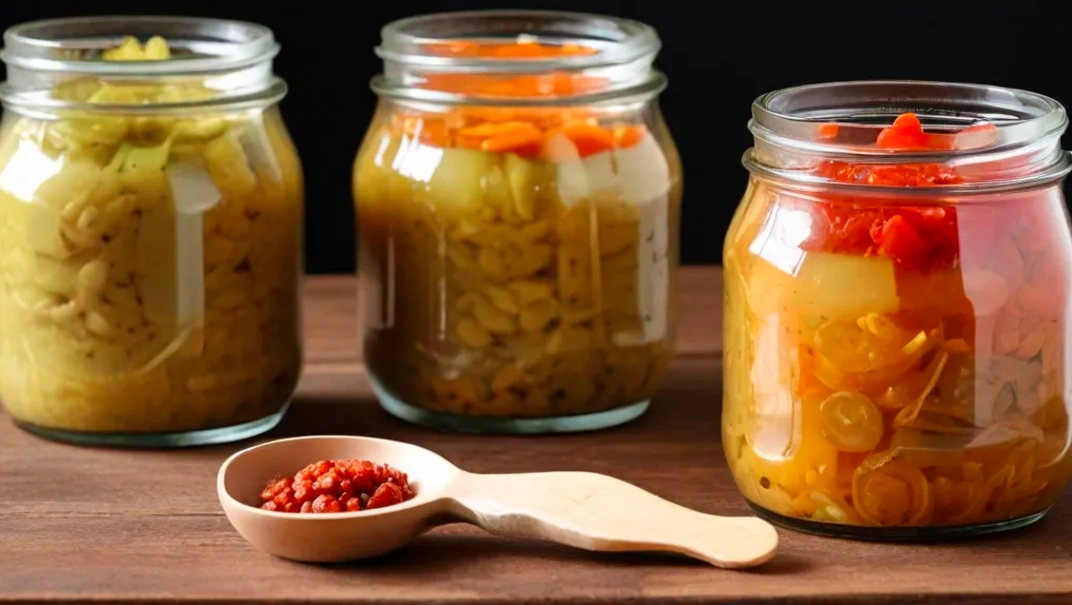Table of Contents
Introduction to Chow-Chow
Definition and Overview
Chow-chow is a type of condiment or pickle that is made from a mixture of vegetables and often served as a side dish or accompaniment to meals. Depending on the region, it can be tangy, spicy, or sweet, and its versatility has made it a beloved staple in various cuisines. The dish, which is typically made from finely chopped vegetables, is known for its ability to add a burst of flavor to any meal. Though it can differ significantly in ingredients and preparation across cultures, its primary role remains consistent: enhancing meals with bold, piquant flavors.
Chow chow recipe is most commonly associated with Southern U.S. cuisine, where it’s used as a topping for dishes like beans, hot dogs, and fried foods. In addition to its popularity in the Southern U.S., chow-chow is also known and enjoyed in several other regions of the world, with variations in both the types of vegetables used and the way it’s made.
Origin and History
Chow-chow has roots in several culinary traditions, with its origins often traced back to pickling practices that have been around for centuries. While the Southern U.S. version of chow-chow is the most commonly recognized today, the dish has an interesting history and widespread cultural significance. It is believed that chow-chow was brought to America through European immigrants, possibly from Germany or France, who brought their own pickling traditions with them. In fact, the word “chow-chow” is thought to come from the Chinese word “chaochow,” referring to a mixture of pickled vegetables.
Over time, various regions in the U.S. adopted their own versions of chow-chow, with Southern chow-chow becoming particularly popular during the 19th and early 20th centuries. It was a convenient way to preserve vegetables, particularly when they were in season, and it became an essential part of the pantry in many households.

Ingredients Used in Chow-Chow
Basic Vegetables
The foundation of any chow-chow is its vegetables. While the specific vegetables can vary by region and personal preference, the most commonly used vegetables include:
- Cabbage: Often used as the base vegetable in Southern chow-chow, cabbage adds crunch and bulk. It also takes on the tangy flavors of the pickling mixture quite well.
- Green Tomatoes: These are a popular choice in many chow-chow recipes. Their firm texture and slightly tart flavor make them an ideal pickling vegetable.
- Bell Peppers: These colorful vegetables add both flavor and a pop of color to chow-chow. Green, red, or yellow bell peppers are used depending on the recipe.
- Onions: Onions lend a savory depth of flavor to the mix, and they pair well with other vegetables and the pickling ingredients.
These vegetables offer a range of health benefits. Cabbage is high in fiber and vitamin C, while green tomatoes are rich in antioxidants like lycopene. Bell peppers are an excellent source of vitamins A and C, and onions contain compounds that may help lower cholesterol and improve heart health.
Seasonings and Spices
The true character of chow-chow lies in its spices and seasonings. These ingredients work together to create a flavorful and sometimes spicy kick. Common seasonings include:
- Mustard Seeds: Mustard seeds add a mild heat and a tangy note that complements the vinegar-based brine in chow-chow.
- Turmeric: Often used for its earthy flavor and bright yellow color, turmeric gives chow-chow its signature hue while contributing anti-inflammatory properties.
- Chili Flakes: For those who like it hot, chili flakes bring a spicy element to the dish. Depending on your preference, the heat level can vary.
- Cloves, Cinnamon, and Allspice: Some recipes include a combination of these warm spices to add complexity and a slightly sweet note.
Together, these spices help balance the tanginess of the vinegar and sweetness of any added sugar or fruit. The spices make chow-chow a versatile dish that can complement both savory and slightly sweet meals.
Preservation Methods
A key feature of chow-chow is its preservation process. The combination of vinegar and sugar acts as both a preservative and flavor enhancer, allowing the vegetables to be stored for extended periods. The vinegar adds acidity, which not only preserves the vegetables but also gives chow-chow its signature tangy taste. Sugar helps to balance the acidity and contributes to the overall flavor profile.
In addition to vinegar and sugar, some recipes may call for a small amount of salt to enhance the flavors further, as well as mustard seeds or other spices, which aid in the preservation. The high acidity ensures that the chow-chow remains safe to consume for weeks or even months when stored properly.

Preparation and Cooking Process
Basic Preparation Steps
Making chow-chow starts with preparing the vegetables. This typically involves chopping the vegetables into uniform pieces. The vegetables are then soaked in a saltwater brine to help draw out excess moisture and to soften them. This process also helps in flavor absorption, as the brine starts infusing the vegetables with the seasonings.
Once the vegetables are prepped, they are often cooked briefly before being combined with the pickling solution, which is made from vinegar, sugar, and spices.
Cooking Techniques
There are different methods of cooking chow-chow, but pickling and boiling are the most common. In the pickling method, the vegetables are added to a pot of simmering vinegar, sugar, and spices. The mixture is heated until it thickens slightly and the vegetables are well coated, but the vegetables retain their crunch. This method works well for chow-chow because it preserves the vegetables while infusing them with the brine’s flavor.
Alternatively, boiling the vegetables briefly helps to soften them, creating a more tender texture. This method often results in a softer chow-chow, but it’s still flavorful and delicious.
Storage and Shelf Life
Chow-chow should be stored in airtight jars or containers. When properly sealed, it can last for several weeks in the refrigerator, or even up to six months if canned and processed correctly. For those who want to preserve it for a longer time, canning the chow-chow in sterilized jars is the best option.
Make sure to store chow-chow in a cool, dark place and consume it within the recommended time to maintain its optimal flavor.
Regional Variations of Chow-Chow
Southern United States Chow-Chow
In the Southern United States, chow-chow is a much-loved condiment, often enjoyed alongside beans, cornbread, or even as a topping for burgers and hot dogs. Southern chow-chow typically includes vegetables like cabbage, bell peppers, and green tomatoes, along with a tangy vinegar brine spiced with mustard seeds, turmeric, and chili flakes.
This version of chow-chow is a versatile accompaniment that has become an integral part of Southern cuisine, particularly in the Appalachian region, where it’s used as a way to preserve the bounty of late summer harvests.
Indian Chow-Chow (Chow Chow Gourd)
In India, chow-chow refers to a different type of vegetable altogether: the chayote squash, also known as the chow-chow gourd. This vegetable is often used in a variety of dishes, including curries, stir-fries, and soups. It is not pickled like its Southern U.S. counterpart, but the vegetable shares a name and the concept of being a staple ingredient in local cuisines.
Chow-Chow in Other Cultures
While Southern and Indian chow-chow are the most recognized versions, other cultures also have their own take on similar vegetable-based condiments. For example, in the Philippines, atchara is a pickled papaya dish that shares similarities with chow-chow. It often includes vegetables like carrots, green beans, and bell peppers, pickled in vinegar and sugar.

Chow-Chow Recipes
Classic Chow-Chow Recipe
To make traditional chow-chow, you’ll need:
- 2 cups chopped cabbage
- 1 cup green tomatoes, chopped
- 1 cup bell peppers, chopped
- 1 medium onion, chopped
- 1 cup vinegar
- 1 cup sugar
- 1 tablespoon mustard seeds
- 1 teaspoon turmeric
- 1 teaspoon chili flakes
- Salt to taste
The vegetables are mixed with salt and left to sit for several hours to release moisture. Then, they are boiled in a brine made from vinegar, sugar, and spices. Once the vegetables are tender, they are placed into sterilized jars and sealed.
Creative Variations
To add a unique twist to chow-chow, consider incorporating fruits like apples or pineapple for a sweet contrast, or adding spices like ginger or cinnamon for an extra layer of flavor.
Chow-Chow as a Side Dish or Ingredient
Chow-chow can be served as a tangy side dish, paired with beans, fried chicken, or barbecue. It also makes a great topping for hot dogs, sandwiches, or burgers, offering a fresh, crunchy contrast to richer dishes.

Health Benefits of Chow-Chow
Nutritional Profile
Chow-chow is packed with vitamins and minerals from its vegetables. It is an excellent source of fiber, vitamin C, and antioxidants, which support digestion and immunity.
Benefits of Fermented Foods
Because chow-chow is often pickled, it contains beneficial bacteria that can aid in gut health and digestion. The fermentation process enhances the bioavailability of nutrients, making chow-chow a healthful addition to your diet.
Conclusion
Summary of Key Points
Chow-chow is a flavorful, versatile condiment made from a mix of vegetables, vinegar, sugar, and spices. It holds cultural significance in both the Southern United States and India, where it has evolved into different variations. Whether you enjoy it as a pickled dish, a side, or a condiment, chow-chow is a delicious way to enhance your meals.
Now that you know what chow-chow is made of and how it’s prepared, why not give it a try? Experiment with different ingredients and spice levels to create your own version. Share your chow-chow recipes or tell us how you use this flavorful dish in your meals!
FAQ Section: Chow-Chow
1. What is chow-chow in the South?
In the Southern United States, chow-chow is a type of pickled relish that typically consists of finely chopped vegetables and a tangy brine. It is most commonly made from cabbage, green tomatoes, bell peppers, onions, and sometimes other vegetables such as carrots or celery. The vegetables are pickled in a brine made from vinegar, sugar, mustard seeds, turmeric, and other spices. The result is a zesty, crunchy condiment that can add a burst of flavor to a variety of dishes.
Chow-chow has deep roots in Southern cuisine, where it has been a staple for centuries. It was traditionally used as a way to preserve the abundance of summer vegetables, particularly at the end of harvest seasons, when homegrown produce was often plentiful. As a preservation method, chow-chow allowed Southern families to enjoy the flavors of summer vegetables well into the colder months, when fresh produce was scarce.
The Southern version of chow-chow is a tangy, sweet-and-sour condiment with a hint of spice. While recipes vary slightly depending on the region or family tradition, the essential ingredients usually include cabbage, green tomatoes, onions, bell peppers, and a vinegar-based brine. The addition of sugar, mustard, and turmeric gives chow-chow its distinct tangy and slightly spicy flavor. Some variations can be spicier, depending on the amount of hot peppers added, while others might include additional spices such as allspice or cloves.
Chow-chow is often enjoyed with foods that have bold, savory flavors, such as barbecue, fried chicken, or beans. It pairs especially well with rich, fatty meats, offering a bright, crunchy contrast that cuts through the heaviness of the dish. This versatility has made chow-chow a beloved and quintessential part of Southern food culture.
2. What do you use chow-chow for in cooking?
Chow-chow is a versatile condiment that can be used in a variety of ways to enhance meals. It is most commonly used as a side dish or topping but can be incorporated into recipes in different forms. Here are some of the ways chow-chow is used in Southern cooking:
- As a condiment: One of the most popular ways to use chow-chow is as a condiment for savory dishes. It’s commonly served as a topping for beans, particularly pintos or black-eyed peas. The tartness and crunch of the chow-chow provide a great contrast to the creamy texture of the beans. Chow-chow is also a great accompaniment to fried foods, like fried chicken, and it pairs perfectly with meats such as barbecue, offering a zesty counterpoint to the smoky, rich flavors of grilled or smoked meat.
- With sandwiches and burgers: Chow-chow can be used as a topping for burgers, hot dogs, or sandwiches, adding a tangy crunch that balances the richness of the meats. It works particularly well on pulled pork sandwiches or as a topping for a classic Southern hamburger.
- As a side dish: In many Southern meals, chow-chow is served as a side dish, often alongside beans, cornbread, or fried green tomatoes. It provides a burst of flavor that complements the more mild flavors of these dishes.
- In salads: Chow-chow can be added to potato salads or coleslaws to add extra flavor and texture. Its tangy and slightly sweet taste can help liven up a simple salad and give it more depth.
- As a marinade or dressing: The pickling liquid in chow-chow can be used as a marinade for meats or vegetables, imparting its tangy flavor. Similarly, the chow-chow itself can be stirred into dressings or dips to give them a punch of acidity and spice.
- For making stews or soups: Chow-chow can be added to soups or stews to enhance their flavor. Its acidity cuts through rich broths and helps brighten the overall taste of the dish.
The versatility of chow-chow is part of what makes it a cherished component of Southern cuisine. Its sweet, sour, and spicy profile can elevate a variety of dishes, from simple everyday meals to special family gatherings.
3. What is piccalilli and chow-chow?
Both piccalilli and chow-chow are types of pickled vegetable relishes, but they have distinct differences in terms of ingredients, preparation, and cultural origins. Here’s a breakdown of both:
- Piccalilli: Piccalilli is a British condiment that closely resembles chow-chow in that it consists of a mixture of pickled vegetables, but it tends to have a spicier and more mustard-forward flavor. Traditionally, piccalilli is made from a combination of vegetables like cauliflower, onions, cucumbers, and green beans, which are chopped and then pickled in a mustard-based sauce, often with the addition of turmeric, mustard seeds, and other spices. Piccalilli typically has a yellow or bright green color, which comes from the turmeric used in the pickling process. It is known for its tangy, spicy, and slightly sweet taste, which makes it an excellent accompaniment to meats, cheese, and cold cuts.
Piccalilli is a staple in British cuisine, particularly in the colder months, where it is used to accompany hearty dishes like meats, cheeses, and even pies. The mustard and turmeric in piccalilli give it a distinctive flavor that is more pungent than the flavor profile of chow-chow.
- Chow-Chow: As discussed earlier, chow-chow is a Southern U.S. pickle relish, with its origins dating back to European pickling traditions. The Southern version of chow-chow is primarily made with vegetables like cabbage, green tomatoes, onions, and bell peppers, and the pickling liquid typically includes vinegar, sugar, mustard seeds, and spices. Chow-chow is usually tangy, sweet, and mildly spicy, with the acidity from the vinegar playing a key role in its flavor. Unlike piccalilli, which often leans heavily on mustard, chow-chow focuses more on the combination of vinegar and sugar to balance the flavors of the vegetables and spices.
Though they share similarities as pickled vegetable relishes, piccalilli and chow-chow differ in flavor due to the varying spices and ingredients used. Piccalilli is more mustard-forward with a stronger spiciness, while chow-chow is a bit milder, relying on vinegar and sugar for its sweetness and tartness. Additionally, piccalilli tends to feature more varied vegetables, often including cauliflower and other ingredients, whereas chow-chow focuses more on cabbage and green tomatoes.
Key Differences Between Piccalilli and Chow-Chow:
- Origin: Piccalilli is from Britain, while chow-chow is a part of Southern U.S. cuisine.
- Vegetables: Piccalilli commonly includes cauliflower, cucumbers, and beans, while chow-chow is made with cabbage, green tomatoes, onions, and bell peppers.
- Flavor Profile: Piccalilli has a mustard-forward, spicy flavor, while chow-chow is tangy, sweet, and sour with a vinegar base.
- Color: Piccalilli is often bright yellow or green due to the turmeric used, while chow-chow is typically more varied in color depending on the vegetables used but is usually a more muted, amber color.
While piccalilli and chow-chow share the same fundamental concept of pickled vegetables, they reflect different cultural influences and offer distinct flavor experiences. Both are enjoyed as condiments or side dishes, adding a burst of flavor to a wide variety of meals.


